Thursday, 27 April 2017
| Room 312 |
15:30 - 17:30 |
Moderators: Bei Zhang |
Slack Channel: #s_int_eng_safety
Session Number: O85
15:30
 |
1217.
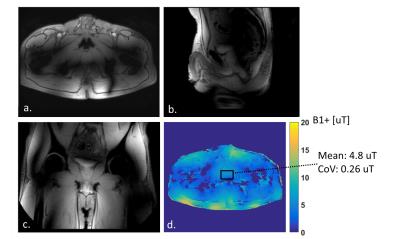 |
Towards massively parallel multi-transmit for body imaging at 7 T 
Bart Steensma, J. Teixeira, Ingmar Voogt, Luijten Peter, Dennis Klomp, van den Berg Nico, Alexander Raaijmakers
A simulation study was done to assess optimal transmit setups for massively parallel (up to 32 channels) transmit body imaging at 7 tesla. Moving from 8 to 24 and 32 dipole setups increases transmit efficiency on a pelvis-shaped phantom. Our current multitransmit system was adapted to obtain 24 semi-phase controlled channels. A 24 channel transmit setup consisting of small dipoles was constructed and tested on a male volunteer.
|
15:42
|
1218.
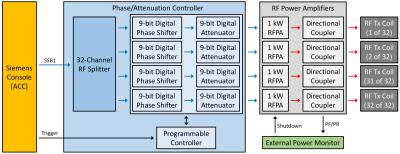 |
An integrated 32-channel transmit and 64-channel receive 7 tesla MRI system 
Edward Auerbach, Lance DelaBarre, Pierre-Francois Van de Moortele, John Strupp, Rene Gumbrecht, Andreas Potthast, Georg Pirkl, Steen Moeller, Brian Hanna, Andrea Grant, Gregor Adriany, Kâmil Ugurbil
At 7T, commercial MRI systems are currently available with a maximum of 8-16 transmit channels and 32 receive channels. To explore the potential benefits of increasing these numbers, which have been predicted by prior experimental and simulation work, we have developed and installed 32-channel RF transmitter and 64-channel receiver upgrades for a standard 7T commercial MRI system. These additions have been fully integrated into the system in a way that they can be reliably employed for routine studies without requiring significant workflow modifications or special user training.
|
15:54
 |
1219.
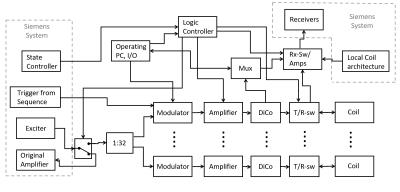 |
A 32-channel transmit system add-on for 7 Tesla body imaging 
Stephan Orzada, Andreas Bitz, Marcel Gratz, Sören Johst, Samaneh Shooshtary, Maximilian Voelker, Stefan Rietsch, Martina Flöser, Ashraf Abuelhaija, Mark Oehmigen, Sascha Brunheim, Thomas Fiedler, Oliver Kraff, Harald Quick, Klaus Solbach, Mark Ladd
At ultra-high field, severe transmit field inhomogeneities affect the quality of imaging. To cope with this, multi-channel solutions are necessary. In this work we present an add-on 32-channel transmit system including an integrated transmit/receive body coil for large field of view imaging. First phantom and in-vivo results are shown. A 50 cm field of view can be achieved and the system is capable of 100 kHz sampling, allowing parallel spatially selective transmit pulses for in-vivo imaging.
|
16:06
|
1220.
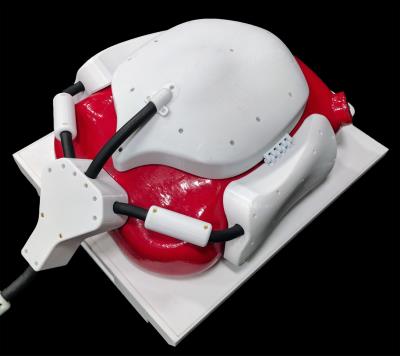 |
A 64 Channel 3T Array Coil for Highly Accelerated Fetal Imaging at 22 Weeks of Pregnancy 
Mark Spatz, Pablo García-Polo, Boris Keil, Christopher Ha, Lawrence Wald
MRI is an attractive tool for fetal imaging due to its unique ability to provide detailed anatomical and physiological data in an inherently safe manner. In practice, fetal MRI is limited by fetal motion, inherently poor SNR in the maternal abdomen, and widely varying body shapes. A 64 channel receive array designed to conform to a range of body shapes at 22 weeks of pregnancy was built and tested. Compared to standard product arrays, the coil provides 5% better SNR in the fetal brain region of an anthropomorphic phantom and allows increasing SENSE acceleration factor from R=4 to R=5.
|
16:18
|
1221.
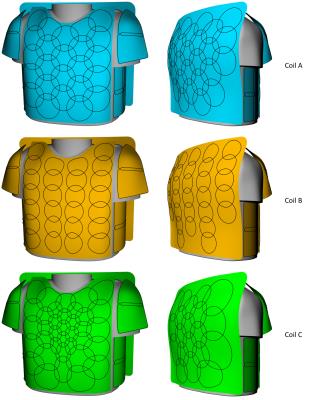 |
Receive Coil Array Considerations for Simultaneous Multislice Imaging in Cardiac MRI 
Robin Etzel, Laleh Golestanirad, Choukri Mekkaoui, Timothy Reese, David Sosnovik, Andreas Mahnken, Boris Keil
Receiver coil array simulation within realistic constrains are helpful for decision-making in coil design, especially when the array comprises many surface coil elements. Three coil array arrangements utilizing 64 loop elements were systematically evaluated regarding their encoding capabilities for accelerated simultaneous multi-slice cardiac acquisitions. Loop arrays consisting of small loop element near target region, but large once beyond the heart, seems to be best-suited for highly accelerated cardiac MRI.
|
16:30
|
1222.
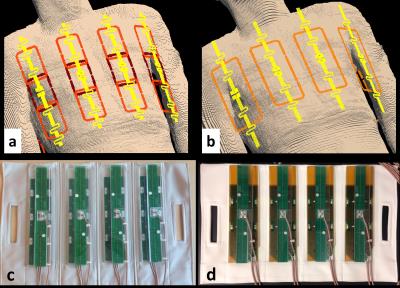 |
A 32-channel loop-dipole transceiver array for body imaging at 7.0 Tesla 
M. Arcan Erturk, Xiaoping Wu, Gregor Adriany, Pierre-Francois Van de Moortele, Edward Auerbach, Andrea Grant, Kamil Ugurbil, Gregory Metzger
A 32-channel transmit/receive (transceiver) body array (32LD) was developed by combining eight dipole elements with 24 loops, 3 each stacked lengthwise under each dipole. The transmit/receive performance was compared against a 16-channel loop-dipole (16LD) array in numerical simulations and phantom experiments. The 32LD had improved SNR near the surface and enabled accelerations in foot-head dimension as expected. Inside deeply situated organs, SNR of 32LD was comparable to 16LD. Furthermore, the 32LD had ~30% higher local SAR than the 16LD with single-spoke RF shimming inside the kidneys and torso. High channel count body imaging arrays can be developed by combining dipoles and loops with geometric decoupling.
|
16:42
|
1223.
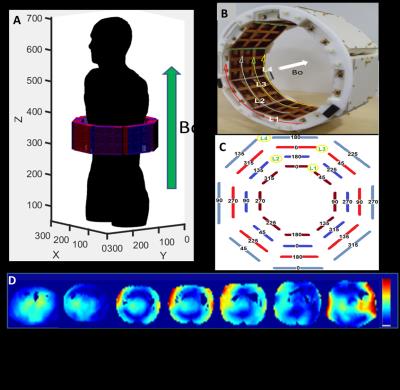 |
In-vivo (8x4) 32-ch Tx-only Body Array for UHF MRI. 
Shailesh Raval, Tales Santini, Sossena Wood, Narayanan Krishnamurthy, Tiejun Zhao, Tamer Ibrahim
The Clinical and Research potential of MRI especially for Whole Body imaging is limitless. Body MR exams are growing part of total clinical MRI exams today. It however faces considerable challenges such as significant rise in RF power deposition in tissue and daunting high field inhomogeneities/signal voids across the anatomy of interest most especially at 7T and higher. This study aims at utilizing the intrinsic sensitivity advantage of 7T by exploring a 32-ch transmit coil design in order to generate a circularly polarized field with homogeneous and extended coverage in abdominal/body regions (liver, kidney, and abdomen in general) at 7T.
|
16:54
|
1224.
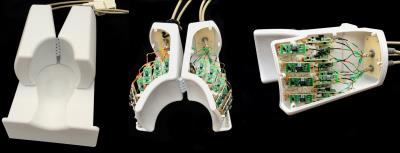 |
Sub-Millimeter Cortical Imaging at 7T using a High-Density Motor-Cortex 32-Channel Array Coil 
Boris Keil, Charlotte Sappo, Berkin Bilgic, Jonathan Polimeni, Laleh Golestanirad, Robin Etzel, Lawrence Wald, David Feinberg, Kawin Setsompop
A densely packed 32-channel motor cortex array coil was designed, constructed and compared to a 32-channel whole-head coil at 7T. The developed design allows coil adaptability to a wide range of head sizes, thereby minimizing the distance of the brain to the individual small loop elements. Using the high SNR and parallelism afforded by this array, a substantial gain in sensitivity and performance for imaging the human motor cortex was achieved, enabling 0.15x0.15x0.65 mm3resolution SWI scans.
|
17:06
|
1225.
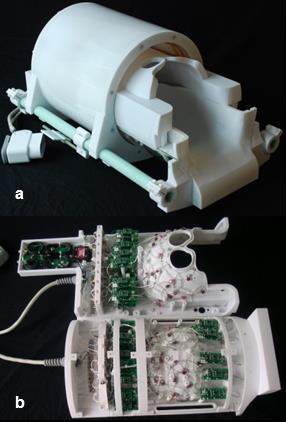 |
31-Channel brain array for hyperpolarized 13C imaging at 3T 
Azma Mareyam, Lucas Carvajal, Duan Xu, Jeremy Gordon, Ilwoo Park, Daniel Vigneron, Sarah Nelson, Jason Stockmann, Boris Keil, Lawrence Wald
We describe the design and the performance of an integrated RF Tx and Rx coil to enable highly accelerated 13C imaging of the human brain at 3T. This system combines a 31-channel receive array with integrated preamps and a high-power transmit coil in an improved mechanical design, overcoming several longstanding design challenges that previously limited hyperpolarized 13C imaging. The shorter imaging times and more uniform spatial coverage attainable with our design will lead to a substantially increase in the range of hyperpolarized imaging applications, and enable the transition to clinical use.
|
17:18
|
1226.
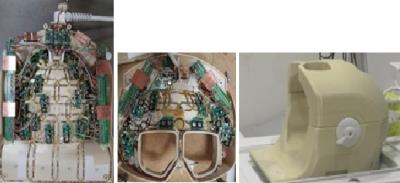 |
Universal Size-Optimized 48-Channel Phased-Array Receive Head Coil for 3T Clinical fMRI/Silent Imaging Application 
Yun-Jeong Stickle, Victor Taracila, Sarah Tenley, Clyve Follante, Balint Franko, Nabeel Malik, Patrick Quarterman, Fotis Vlachos, Peter Roemer
Typical high density phased-array head coils are design to fit tightly around the head to achieve increasing SNR and improving acceleration limiting space and excluding its use for larger patients. This study shows the results for an optimized 48-Channel phased-array receive head coil design on a universally sized football helmet-shaped former (fitting to more than 99th - percentile US male) providing similar SNR and improved acceleration compared to a 32-Channel close-fitting design coil. The performance of this array is demonstrated in highly accelerated head images on variously sized human subjects. This coil is optimized for Hyperband, fMRI and Silent imaging.
|
|











